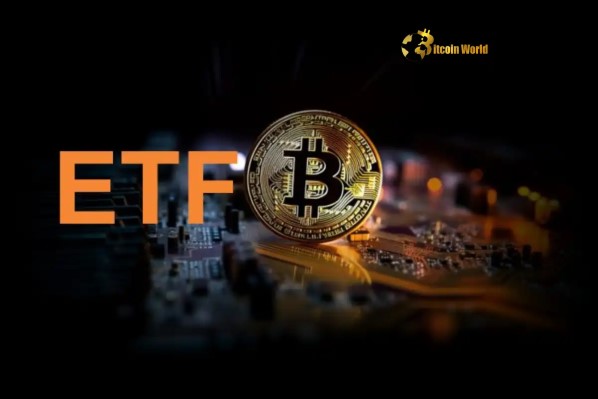BitcoinWorld

Ethereum Institutional Interest: Unlocking the Future of Finance
Are you watching the seismic shifts in the financial world? A quiet revolution is underway, and at its heart is Ethereum institutional interest. Once seen as a fringe technology, Ethereum is now drawing serious attention from major players in traditional finance. This isn’t just hype; it’s a strategic realignment driven by Ethereum’s unique capabilities in powering the next generation of financial infrastructure.
The Surging Wave of Ethereum Institutional Interest
For years, institutions largely viewed cryptocurrencies with skepticism. Bitcoin garnered some attention as “digital gold,” but Ethereum institutional interest was a slower burn. That’s rapidly changing. Recent reports from financial giants like Fidelity and innovative firms such as Electric Capital are repositioning Ethereum not just as a speculative asset, but as a fundamental building block for the future economy. They see ETH as a powerful “digital oil” fueling the on-chain economy, a potential reserve asset, and even a store of value.
Why this sudden shift? Institutions are recognizing Ethereum’s unparalleled network effect, its robust developer community, and its proven track record. It’s becoming clear that the decentralized applications (dApps) and financial services being built on Ethereum offer efficiencies and opportunities simply not possible in traditional systems. This growing understanding is a significant driver behind the current wave of institutional adoption.
Driving Adoption: Ethereum’s Dominance in Stablecoin Expansion
One of the clearest indicators of Ethereum’s foundational role in the digital economy is its undisputed leadership in stablecoin expansion. A staggering 54% of all stablecoin issuance occurs on the Ethereum blockchain. Stablecoins, pegged to fiat currencies like the US Dollar, act as the bridge between traditional finance and the crypto world, offering stability and predictability in volatile markets.
For institutions, stablecoins are crucial. They facilitate seamless cross-border payments, enable rapid settlement, and provide a stable medium for transactions within decentralized finance (DeFi) protocols. Ethereum’s robust infrastructure, security, and liquidity make it the preferred platform for issuing and trading these essential digital assets. This dominance isn’t just about market share; it signifies trust and utility that traditional financial entities increasingly rely on.
Revolutionizing Finance with Real-World Assets (RWAs)
Beyond stablecoins, another transformative trend capturing institutional attention is the tokenization of real-world assets (RWAs) on Ethereum. Imagine unlocking the value of everything from real estate and fine art to commodities and private credit, making them accessible, liquid, and programmable on a blockchain. This is precisely what RWA tokenization offers.
Ethereum provides the ideal rails for this innovation. By tokenizing RWAs, institutions can:
- Enhance Liquidity: Fractionalize illiquid assets, making them tradable 24/7 on global markets.
- Increase Transparency: Leverage blockchain’s immutable ledger for clear ownership records and transaction histories.
- Reduce Costs: Streamline processes, cut out intermediaries, and lower transaction fees.
- Expand Access: Open up investment opportunities to a broader range of investors, both institutional and retail.
From tokenized government bonds to securitized loans, Ethereum is becoming the go-to platform for bringing traditional assets onto the blockchain, bridging the gap between old and new finance. This burgeoning sector is a key area where institutions see immense potential for efficiency and new revenue streams.
Unlocking Value: The Allure of Ethereum Staking Yield and Scalability
Following its monumental shift to Proof-of-Stake (PoS) with The Merge, Ethereum now offers another compelling incentive for institutions: Ethereum staking yield. By staking their ETH, institutions can earn a passive income, contributing to the network’s security and earning rewards in return. This yield, often comparable to or exceeding traditional fixed-income returns, is highly attractive to institutional portfolios seeking diversified sources of income.
Furthermore, Ethereum’s commitment to scalability through Layer-2 (L2) solutions addresses one of the primary concerns for institutional adoption: high transaction fees and network congestion. L2s like Arbitrum, Optimism, and Polygon process transactions off the main Ethereum chain, bundling them and settling them on the mainnet. This significantly reduces fees and increases transaction throughput, making Ethereum a more viable and cost-effective platform for large-scale institutional operations. The combination of attractive yields and improved efficiency makes Ethereum a compelling choice.
Bridging the Gap: The Rise of TradFi Crypto Adoption on Ethereum
The synergy between traditional finance (TradFi) and the crypto world, often termed TradFi crypto adoption, is accelerating, with Ethereum at the forefront. Institutions are not just investing in ETH; they are actively exploring and integrating Ethereum-based protocols into their operations. This includes participating in decentralized finance (DeFi) protocols, building permissioned blockchains on Ethereum’s technology stack, and exploring tokenized securities.
The recent surge in ETH’s price, up 23% this week and outpacing Bitcoin, is a testament to this growing alignment. Analysts, including those cited by Cointelegraph, point to this increasing TradFi interest as a key driver. Institutions are drawn to Ethereum’s composability – the ability to seamlessly combine different DeFi protocols like LEGO bricks – to create innovative financial products and services. This integration is paving the way for a hybrid financial system where the best of traditional finance meets the efficiency and transparency of blockchain technology.
Challenges and the Path Forward
While the momentum for Ethereum institutional interest is undeniable, challenges remain. Regulatory clarity is still evolving globally, and institutions require robust frameworks to operate confidently. Scalability, while significantly improved by L2s, will need continuous innovation to handle truly global, high-frequency institutional volumes. Security also remains paramount, requiring sophisticated solutions to protect large pools of institutional capital.
However, the industry is actively addressing these issues. Collaborative efforts between blockchain developers, financial institutions, and regulators are shaping a future where Ethereum can fully realize its potential as the backbone of a new global financial system. The long-term adoption narrative for ETH is strong, supported by its vibrant ecosystem, continuous technological advancements, and its increasing appeal to the world’s largest financial players.
Conclusion: Ethereum’s Enduring Impact on Global Finance
The narrative is clear: Ethereum institutional interest is not a fleeting trend but a fundamental shift. Its dominance in stablecoin issuance, its pioneering role in real-world assets tokenization, the attractive Ethereum staking yield, and its evolving scalability solutions are cementing its position as a critical infrastructure layer for the future of finance. As TradFi crypto adoption accelerates, Ethereum stands poised to be the engine driving innovation, efficiency, and accessibility across global markets. This convergence promises a more interconnected, transparent, and ultimately, a more powerful financial landscape for everyone.
To learn more about the latest Ethereum trends, explore our article on key developments shaping Ethereum institutional adoption.
This post Ethereum Institutional Interest: Unlocking the Future of Finance first appeared on BitcoinWorld and is written by Editorial Team





